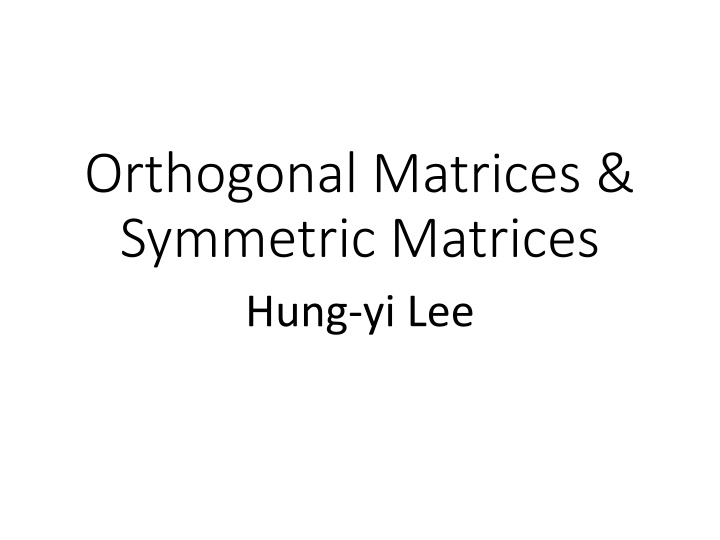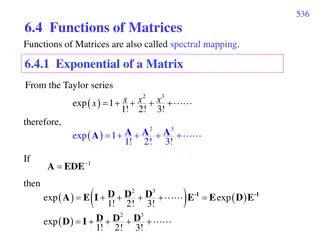
Exploring Orthogonal and Symmetric Matrices - Insights by Hung-yi Lee
Unlock the intricacies of orthogonal and symmetric matrices with enlightening insights by Hung-yi Lee, diving into norm-preservation, necessary conditions, properties, and more in linear algebra.
Download Presentation

Please find below an Image/Link to download the presentation.
The content on the website is provided AS IS for your information and personal use only. It may not be sold, licensed, or shared on other websites without obtaining consent from the author. If you encounter any issues during the download, it is possible that the publisher has removed the file from their server.
You are allowed to download the files provided on this website for personal or commercial use, subject to the condition that they are used lawfully. All files are the property of their respective owners.
The content on the website is provided AS IS for your information and personal use only. It may not be sold, licensed, or shared on other websites without obtaining consent from the author.
E N D
Presentation Transcript
Orthogonal Matrices & Symmetric Matrices Hung-yi Lee
Outline Orthogonal Matrices Reference: Chapter 7.5 Symmetric Matrices Reference: Chapter 7.6
Norm-preserving A linear operator is norm-preserving if ? ? = ? For all u Example: linear operator T on R2that rotates a vector by . Is T norm-preserving? ? =1 0 Example: linear operator T is refection Is T norm-preserving? 0 1
Norm-preserving A linear operator is norm-preserving if ? ? = ? For all u Example: linear operator T is projection Is T norm-preserving? ? =1 0 0 0 Example: linear operator U on Rnthat has an eigenvalue 1. U is not norm-preserving, since for the corresponding eigenvector v, U(v) = v = v v .
Orthogonal Matrix An nxn matrix Q is called an orthogonal matrix (or simply orthogonal) if the columns of Q form an orthonormal basis for Rn Orthogonal operator: standard matrix is an orthogonal matrix. unit unit is an orthogonal matrix. orthogonal
Norm-preserving Necessary conditions: Norm- preserving Orthogonal Matrix ? ??? Linear operator Q is norm-preserving qj = 1 qj = Qej = ej qiand qjare orthogonal qi+ qj 2= Qei+ Qej 2= Q(ei+ ej) 2 = ei+ ej 2= 2 = qi 2+ qj 2
Those properties are used to check orthogonal matrix. Orthogonal Matrix Q is an orthogonal matrix ???= ?? ? is invertible, and ? 1= ?? ?? ?? = ? ? for any u and v ?? = ? for any u Simple inverse Q preserves dot projects Q preserves norms Norm- preserving Orthogonal Matrix
Orthogonal Matrix Let P and Q be n x n orthogonal matrices ???? = 1 ?? is an orthogonal matrix ? 1 is an orthogonal matrix ?? is an orthogonal matrix Check by ?? 1= ??? Check by ? 1 1= ? 1 ? Proof (a) QQT= In det(In) = det(QQT) = det(Q)det(QT) = det(Q)2 det(Q) = 1. (b) (PQ)T = QTPT= Q 1P 1 = (PQ) 1. Rows and columns
Orthogonal Operator Applying the properties of orthogonal matrices on orthogonal operators T is an orthogonal operator ? ? ? ? = ? ? for all ? and ? ? ? = ? for all ? Preserves dot product Preserves norms T and U are orthogonal operators, then ?? and ? 1 are orthogonal operators.
Example: Find an orthogonal operator T on R3such that 0 1 0 1 2 Norm-preserving ? = 0 1 2 1 2 Find ? 1 first Because ? 1= ?? ? = ? 1?2 ?? = ?2 ? = 0 1 2 Also orthogonal 1 2 ? 1= 0 1 2 1 2 0 1 0 1 2 ? 1= 0 0 1 2 1 2 1 2 0 1 0 1 1 2 2 0 0 1 1 1 2 0 ? = ? 1 ?= 2 1 2 0 0
Conclusion Orthogonal Matrix (Operator) Columns and rows are orthogonal unit vectors Preserving norms, dot products Its inverse is equal its transpose
Outline Orthogonal Matrices Reference: Chapter 7.5 Symmetric Matrices Reference: Chapter 7.6
Eigenvalues are real The eigenvalues for symmetric matrices are always real. How about more general cases? Consider 2 x 2 symmetric matrices ??? ? ??2 = ?2 ? + ? ? + ?? ?2 The symmetric matrices always have real eigenvalues.
Orthogonal Eigenvectors A is symmetric ??? ? ??? Factorization ?1? ?2 ?2 ? ?? ?? = ? ?1 ?1 ?1 ?2 ?2 ?? Eigenvalue: ?? ?? ?2 ?1 Eigenspace: (dimension) orthogonal Independent
Orthogonal Eigenvectors A is symmetric. If ? and ? are eigenvectors corresponding to eigenvalues ? and ? (? ?) ? and ? are orthogonal.
Diagonalization A = ?DP? P560 ? A is P?A? = D symmetric P is an orthogonal matrix D is a diagonal matrix : simple P?A? = D P 1A? = D A = ?DP 1 Diagonalization A = ?DP? P consists of eigenvectors , D are eigenvalues
Diagonalization Example A = ?DP? 2 2 A = ?DP 1 = A 2 5 P?A? = D A has eigenvalues 1= 6 and 2= 1, with corresponding eigenspaces E1 = Span{[ 1 2 ]T} and E2 = Span{[ 2 1 ]T} orthogonal B1 = {[ 1 2 ]T/ 5} and B2 = {[ 2 1 ]T/ 5} 1 2 2 6 0 0 1 1 = = and . P D 1 5
Example of Diagonalization of Symmetric Matrix A = ?DP? A = ?DP 1 P is an orthogonal matrix Gram- Schmidt Intendent 1= 2 1 1 6 6 1 1 0 1 0 1 1 1 2 Eigenspace: ???? , ???? , 2 normali zation 0 2 6 Not orthogonal 2= 8 1 1 1 3 3 3 1 1 1 Eigenspace: ???? ???? normalization 1 1 6 6 1 1 1 3 3 3 2 0 0 0 2 0 0 0 8 1 1 2 ? = ? = 2 0 2 6
Diagonalization P is an orthogonal matrix A is P?A? = D symmetric A = ?DP? P consists of eigenvectors , D are eigenvalues Finding an orthonormal basis consisting of eigenvectors of A (1) Compute all distinct eigenvalues 1, 2, , kof A. (2) Determine the corresponding eigenspaces E1, E2, , Ek. (3) Get an orthonormal basis Bifor each Ei. (4) B = B 1 B 2 B kis an orthonormal basis for A.
Diagonalization of Symmetric Matrix ? = ?1?1+ ?2?2+ + ???? ? ?1 ? ?2 ? ?? Orthonormal basis ?B ? ?B ? ?B simple Eigenvectors form the good system ? 1 ? 1 ? ? Properly selected Properly selected ? = ??? 1 ? ? ? A is symmetric
Spectral Decomposition Orthonormal basis Let P = [ u1u2 un] and D = diag[ 1 2 n]. A = PDPT = P[ 1e1 2e2 nen]PT = [ 1Pe1 2Pe2 nPen]PT= [ 1u1 2u2 nun]PT ?1 ?2 ?? = ?1P1+ ?2P2+ + ??P? ?? are symmetric
Spectral Decomposition Orthonormal basis A = PDPT Let P = [ u1u2 un] and D = diag[ 1 2 n]. = ?1P1+ ?2P2+ + ??P?
Spectral Decomposition Example 3 4 3 ? = Find spectrum decomposition. 4 4 5 2 5 1 5 Eigenvalues 1= 5 and 2= 5. ?= ?1= ?1?1 2 5 1 5 2 5 An orthonormal basis consisting of eigenvectors of A is 2 1 5 ?1 2 5 4 5 ?= ?2= ?2?2 ?2 5 1 2 5 5 ? = , ? = ?1?1+ ?2?2
Conclusion Any symmetric matrix has only real eigenvalues has orthogonal eigenvectors. is always diagonalizable P?A? = D A = ?DP? A is symmetric P is an orthogonal matrix
Diagonalization By induction on n. n = 1 is obvious. Assume it holds for n 1, and consider A R(n+1) (n+1). A has an eigenvector b1 Rn+1corresponding to a real eigenvalue , so an orthonormal basis B = {b1, b2, , bn+1} by the Extension Theorem Extension Theorem and Gram- Schmidt Process.
T T T T b b b b b b b A A A + 1 T 1 T 1 1 T 2 1 T 1 n b b b b b b b A A A + = = T 2 2 1 2 2 2 1 n b b b B AB A A A + 1 2 1 n T n T n T n T n b b b b b b b A A A + + + + + 1 0 1 1 1 2 1 1 n T = = = and = = T T T j T b b b b b b b b since , 0 . 1 A A A j 1 1 1 1 1 1 j 0 S S = ST Rn n an orthogonal C Rn nand a diagonal L Rn n such that CTSC = L by the induction hypothesis. T T T T T T T 0 0 0 0 0 0 0 1 0 1 0 1 0 1 0 = = = T B A B T T T 0 0 0 C C C S C C SC L orthogonal P orthogonal P diagonal D T
Example: reflection operator T about a line L passing the origin. Question: Is T an orthogonal operator? (An easier) Question: Is T orthogonal if L is the x-axis? b1is a unit vector along L. b2is a unit vector perpendicular to L. P = [ b1b2] is an orthogonal matrix. B = {b1, b2} is an orthonormal basis of R2. [T]B= diag[1 1] is an orthogonal matrix. Let the standard matrix of T be Q. Then [T]B= P 1QP, or Q = P[T]BP 1 Q is an orthogonal matrix. T is an orthogonal operator.






















